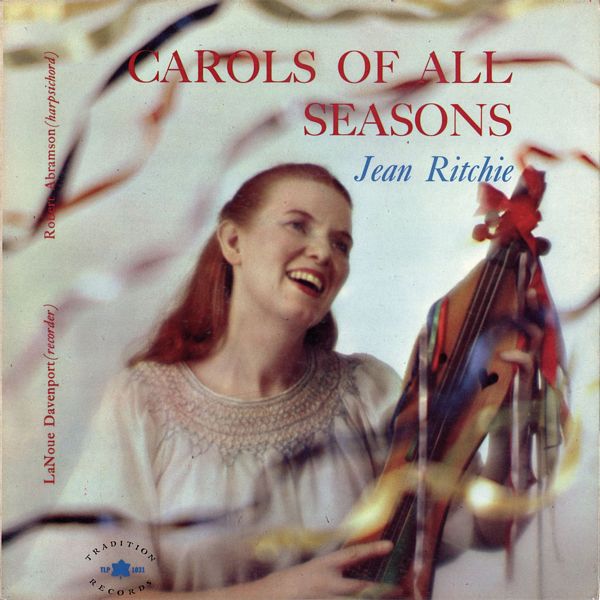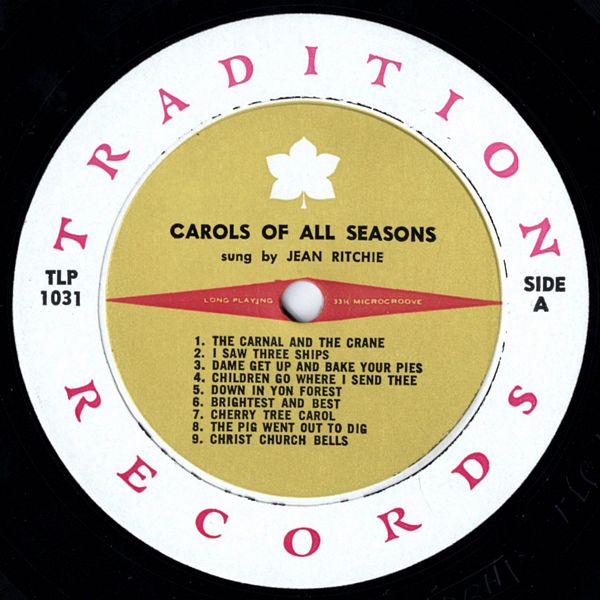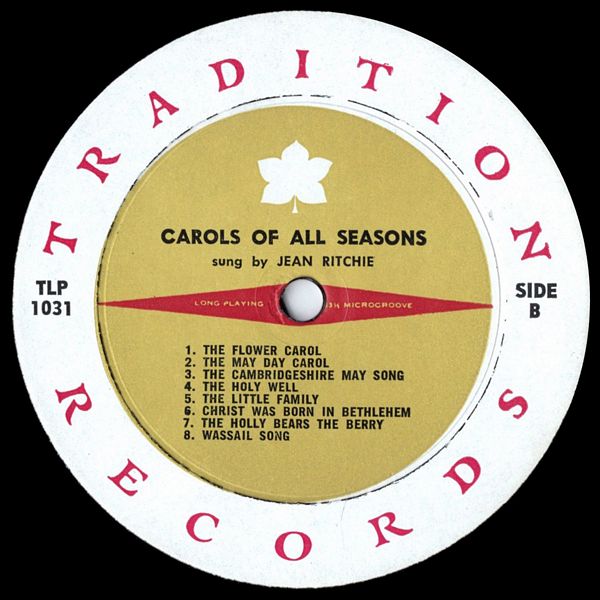

 |



|
Sleeve Notes
JEAN RITCHIE is undoubtedly America's best known traditional folk singer. As a member of "the singing Ritchie's of Kentucky" whose talents brought many folksong collectors to their door (including the renowned Cecil Sharp), Jean was brought up in one of the richest musical traditions in the world. She has appeared on television and radio and has given numerous recitals and lecture-concerts throughout the United States and the British Isles. She has recorded many songs from her vast repertoire for the Library of Congress and the BBC archives as well as another record for Tradition: AMERICAN FOLK TALES AND SONGS, TLP 1011. She is the author of four books: The Swapping Song Book (1952), A Garland of Mountain Song (1953), Singing Family of the Cumberlands (1954), and From Fair to Fair (Spring, 1960).
THE CARNAL AND THE CRANE. (Instrumental: harpsichord and recorder)
The ballad, "The Carnal and the Crane," as printed in The Oxford Book of Carols, (Oxford Press, 1928), concerns a discussion between a carnal (probably from the French corneille, a crow) and a crane of the facts surrounding the miraculous birth of Jesus. The carol was not one I had chosen to sing for this album, but Mr. Davenport and Mr. Abramson both fell in love with the haunting melody, so well suited to their instruments.
I SAW THREE SHIPS
In our family, this carol is associated, by me at least, with my sister Patty. I remember her singing it about the housework when I was a very little girl. She and the other girls who were lucky enough to go away to high school at The Pine Mountain Settlement School probably learned it there and brought it home. Much later, when I came to work in New York City, I attended a party given by the Country Dance Society and found myself dancing an old English holiday processional to the tune of "I Saw Three Ships."
DAME GET UP AND BAKE YOU PIES
Those who like English folk songs will recognize the tune of this children's game- song as that of "Greensleeves" speeded up to dance tempo. Actually, the original use of the "Greensleeves" tune was for morris dancing, and still is today. The composer of the love-lyrics (Henry VIII, presumably) slowed the tempo down to suit his tender words. My children's game-song, then, is closer to the original than the better-known love song, and much more fun to sing.
CHILDREN GO WHERE I SEND THEE
The Ritchies learned this song from Opal Payne, Hindman, Ky., "visiting game-teacher" to all the Knott County schools. On one of her visits to the Breedings Creek Colored School, she found the children lined up, boys on one side of the room facing the girls on the other singing "Children Go" in answer-back fashion. She took down the song and taught it to the folks at the Hindman Settlement School. Everyone loved it; it caught on and spread like a brush-fire. Pauline, who was at Hindman then, brought it back to the rest of us.
DOWN IN YON FOREST
I have always thought of this as a Christmas carol, but after recording it as I remembered it from childhood, I paid close attention to the words for the first time and also compared it to a very similar version that was collected from a Mr. Hall, Castleton, Derbyshire by Ralph Vaughn Williams and published in England by Stainer and Bell. In this version, as in ours, all the mystical allusions concern the crucifixion of Christ, which would make it more fitting as an Easter- tide carol. A footnote to Mr. Hall's version in The Oxford Book of Carols hints that the "bed" under which runs a "flood" may have referred in the original form of the song to an altar and a sacrifice. This suggests, to my mind, that the song existed in pre-Christian times, and that the last verse with its mention of Christ (the Richard Hill MS., 1500, printed by Dyboski) was later added by singers who hoped thus to gain church approval for the song which they were reluctant to give up. This, however, is my own notion, and I have no scholarly proof to support it. Certainly our "modern" version (the one sung on this record) which speaks of the Virgin Mary kneeling on the stone and has the refrain saying, "I love my Lord Jesus above anything," has come a long way from the old Hill MS.
BRIGHTEST AND BEST
"On Old Christmas Eve we'd sit fore the fire and Mom and Dad and Granny'd tell us about the baby Jesus born in a stable on this night, and they'd say that if we'd go out at midnight we'd see the old elderberry bush blooming in the fence corner right in the snow, and that if we peeped in through a chink in our stable and make no racket at all we'd see the cow and the old mule kneeling down — paying honor to the little King of Kings. Then maybe Granny'd sing us her Christmas carol — 'Brightest and Best' in the old mountain tune — and we'd all sing some. All of us would try to stay up until midnight so we could go see the elderberry blossoms, and the brutes kneeling down, but we were all used to going to bed at the edge of dark and we never could keep awake that long. That used to be our Christmas. It was a good. peaceful kind of time . . . Now I guess everybody celebrates the Day this (new) way . . . hut in the evening of the fifth day of January, I always remember Granny Katty sitting bowed over the fire, singing of the little Babe with dewdrops a-shining on His cradle." (From SINGING FAMILY OF THE CUMBERLANDS by J. Ritchie).
CHERRY TREE CAROL
I learned this from "Uncle" Jason Ritchie, really my father's first cousin. but everybody called him Uncle. In Uncle Jason's words (from SINGING FAMILY OF THE CUMBERLANDS): "Now, have you ever heard that'n about Mary and Joseph and the argument over the cherry tree? Well, that's a kind of quare song, little story I guess never got printed in the Bible, but it got told by a whole lot of folks, and might be true, don't you know!"
THE PIG WENT OUT TO DIG
If this little love of a song has any deep meanings, I don't know, though some claim it has. I first heard it one summer at the John C. Campbell Folk School in Brasstown, N.C. It was printed in a little songbook. Songs of All Time, published by Rohrbough at the Cooperative Recreation Service, Delaware, Ohio, and his source was English County Songs published by J. B. Cramer and Co., Ltd. That summer. "There was a Pig" became everybody's favorite, and we were all making up verses, and I'm sure that is exactly how the song was born in the first place, a gay little chant started in an immortal happy moment of time by a child, or for a child, and added to and enjoyed and cherished by children ever since.
CHRIST CHURCH BELLS
Marguerite Bidstrup of Brasstown, N.C. and Philip Merrill of N.Y.C. are the people most responsible for my taking liberties with this English processional dance tune. Twelve years ago, at Mr. Merrill's suggestion we hummed it together as a three-part canon and since that night, the thing has haunted me. Finally, when I was gathering carols for this record, the idea of Christmas words for "Christ Church Bells" first occurred to me. I started humming the tune with this in mind and the words fairly burst forth with no effort on my part. I hummed the melody for Mr. Abramson and Mr. Davenport, and we thought it would be fun to "sing" it in three parts, using the harpsichord and the recorder as the first and second voices, and I to come in as the third. This is what you hear on this — record — an experiment, played and sung for the fun of it.
THE FLOWER CAROL
In my family, we have always known and loved "Good King Wenceslas" sung to this tune, not knowing that any other words existed. I was surprised, therefore, to read this note about "Good King Wenceslas" in The Oxford Book of Carols. "This rather confused narrative owns its popularity to the delightful tune, which is that of a Spring carol. 'Tempus adest floridum', No. 991. Unfortunately, Neale2 in 1853 substituted for the Spring carol this 'Good King Wenceslas', one of his less happy pieces, which E. Duncan goes so far as to call. 'doggeral', and Bullen condemns as 'poor and commonplace to the last degree' . . . we reprint the tune in its proper setting not without hope that . . . 'Good King Wenceslas' may gradually pass into disuse, and the tune restored to springtime." Now, over one hundred years since the legend of the Good King was invented, it seems a forlorn hope on the part of the editors that he will eventually die a natural death. I am, like the rest of the world, fond of "Wenceslas." But, having a bit of the purist in me and being ever the one to want to set matters straight, I chose to record on this album of carols, the original "Flower Carol."
1. From a rare Swedish hook, Piae Cantiones
2. The Reverend J.M. Neale
THE MAY DAY CAROL came into my family when I was very young, so that to me it seems to belong in the Ritchie tradition. My older sisters learned it at the Pine Mountain Settlement School and although it is English, Kitty, Patty, Edna and Jewel lost no time in making it their own. The English custom on May Day is to go in a group about the village singing May carols and leaving fresh May greens. In Kentucky, we made May baskets with flowers and greenery gathered in the woods and left them at our friends doors, hut we didn't dare linger to sing for fear we'd be recognized (and the fun was to guess who made each basket). So we sang the carol on any soft spring evening when the family and friends gathered to share good talk, stories and music.
THE CAMBRIDGESHIRE MAY SONG
In Stratford- Upon-Avon, in England in 1953, Mr. Russell Wortley sang for me this lovely carol. It has been sung for centuries by young men and girls in Camhridgeshire on May Day mornings. The "may," green boughs and spring flowers, is gathered the night before, or very early on May Day Morning, and carried by the group from house to house throughout the village. At each cottage, the song is sung, (lie "may" is hung over the door (to insure prosperity, health and good farm yields for the coming year), the carollers pass their money-box and walk along to the next house. This song has doubtless been well published in England; I confess I don't know where. I sing it for you here as I heard it from Russell Wortley.
THE HOLY WELL
The beauty of this legendary carol, about an incident in the childhood of Jesus, lies in "it's human interest" and in its tune, so simple and yet so fragile it seems it might break if breathed upon heavily. The little boy Jesus asks His mother if He may go to play; He goes down by the well and meets some children who refuse. to play with Him because they are lords' sons and He is only a "simple fair maid's child." The little boy heartbrokenly runs home in tears and tells His mother and she reacts as all mothers are tempted to do — bids Him go back and get even. These words are those given in The Oxford Book of Carols. The melody is a traditional English one I learned to "Lady Maisry."
THE LITTLE FAMILY
My mother, Abbigail Hall Ritchie, has always sung this song — and so did her mother and father before her — in church, working around the house, rocking her many babies to sleep. I don't recollect that it was published anywhere; folks just knew it. I think it is comparatively rare — there is an Ozark version which I beard recently, and MacEdward Leach in The Ballad Book (Harper & Brothers) prints a text as sung by Mrs. Tiny Gaunt, Rappahannock County, Virginia. There might be arguments amongst the experts as to whether or not "The Little Family" is a carol. In support of my belief that it is, let me quote Dearmer's definition in his preface to The Oxford Book of Carols: "Carols are songs with a religious impulse that are simple, hilarious, popular, and modern. They are generally spontaneous and direct in expression, and their simplicity of form causes them sometimes to ramble on like a ballad. Carol literature and music are rich in true folk-poetry and remain fresh and buoyant even when the subject is a grave one . . . there are some which do not possess all the typical characteristics. . . The typical carol gives voice to the common emotions of healthy people in language that can he understood and music that can be shared by all."
CHRIST WAS BORN IN BETHLEHEM
This Easter ballad is one of the most beautiful and moving in my family repertoire. As in "The Holy Well," the country folksinger has given the members of the holy family the feelings, actions and speech of real people, and again it is this human thing that reaches out of the song to touch our hearts. Cecil Sharp (English Folk Songs from the Southern Appalachians) gives a North Carolina source for the carol. Evelyn K. Wells in The Ballad Tree gives us the version she learned from Edna Feltner in Kentucky, calling it "Edna's Song." We Ritchies call it "Jewel's Song" because it was my sister Jewel who found it and brought it to us. When she was teaching her first school, one little feller kept calling out, "Let's sing 'Down Came an Angel!' Jewel didn't know the song, but finally one morning she said to him, "All right, but you'll have to stand up and lead it." So be and a few others that knew it sang out, and the whole school then sang it with them. The only other persons I have heard sing variants of "Christ Was Born" are the Hall family, woodcarvers in Brasstown, N.C., and Mrs. Baker in New York, who says she remembers the miners' wives singing it from house to house in Wigan, England when she was a girl.
THE HOLLY BEARS THE BERRY
I learned this carol one Christmastime from Mrs. Raymond K. McLain at Berea, Kentucky. She had learned it from an old book, and that book was probably, The Oxford Book of Carols, where I myself later ran across it under the title of "Sans Day Carol." The footnote therein explains the title and gives the sources: ". . . has been so named because the melody and the first three verses were taken down at Saint Day in the parish of Gwennap, Cornwall. Saint Day (or Saint They) was a Breton saint whose cult was widely spread in Armorican Cornwall. We owe the carol to the kindness of the Rev. G.H. Dohle, to whom Mr. W.D. Watson sang it after hearing an old man, Mr. Thomas Beard, sing it at Saint Day."
WASSAIL SONG (Instrumental: harpsichord and recorder)
The "Wassail Song" has been sung by the Waits in England since the 17th century and most probably earlier; it is perhaps the most popular Christmas and New Years carol of all. One can imagine the Waits, or carollers, walking briskly about the village on a cold Christmas Eve. What better way to keep warm and jolly than to keep singing the rollicking "Wassail Song", it makes one dance just to hear it! The words, not sung here but undoubtedly familiar to everybody, leave nothing to be desired. The various verses include blessings on the house and all therein, an identification of the singers as neighbors and friends (not daily beggars!), a request for refreshments (barley beer, cheese, Christmas loaf), a good-bye and the best wishes of the season, which, by the way, is our wish for yon:
Love and joy come to you,
And to you your wassail too,
And God bless you and send you
A happy New Year.
— JEAN RITCHIE